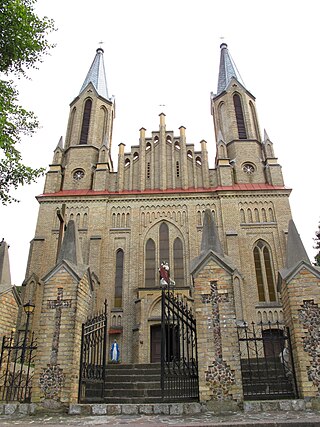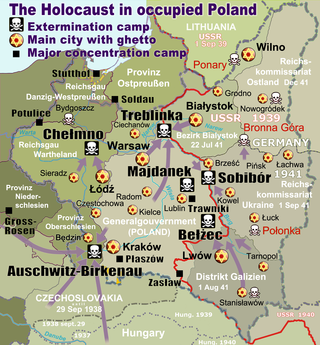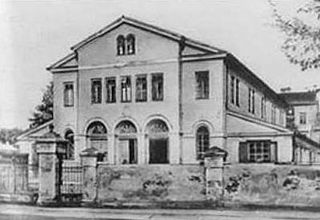
Krynkipronounced[ˈkrɨŋkʲi] is a town in northeastern Poland, located in Podlaskie Voivodeship along the border with Belarus. It lies approximately 24 kilometres (15 mi) south-east of Sokółka and about 45 km (28 mi) east of the regional capital Białystok.

Lubartów Ghetto was established by Nazi Germany in occupied Poland during World War II, and existed officially from 1941 until October 1942. The Polish Jews of the town of Lubartów were confined there initially. The ghetto inmates also included Jews deported from other cities in the vicinity including Lublin and Ciechanów and the rest of German-occupied Europe for the total of 3,500 Jews in its initial stages including 2,000 Jews from Slovakia. In May 1942 additional transport from Slovakia with 2,421 Jews arrived.

The Dzyatlava massacres were two consecutive mass shooting actions carried out three months apart during the Holocaust. The town of Zdzięcioł was located in the Nowogródek Voivodeship of the Second Polish Republic prior to World War II.

Łomazy is a village in Biała Podlaska County, Lublin Voivodeship, in eastern Poland. It is the seat of the gmina called Gmina Łomazy. It lies approximately 16 kilometres (10 mi) south of Biała Podlaska and 84 km (52 mi) north-east of the regional capital Lublin.

The Częstochowa Ghetto was a World War II ghetto set up by Nazi Germany for the purpose of persecution and exploitation of local Jews in the city of Częstochowa during the German occupation of Poland. The approximate number of people confined to the ghetto was around 40,000 at the beginning and in late 1942 at its peak, immediately before mass deportations, 48,000. Most ghetto inmates were delivered by the Holocaust trains to Treblinka extermination camp, where they were murdered. In June 1943, the remaining ghetto inhabitants launched the Częstochowa Ghetto uprising, which was extinguished by the SS after a few days of fighting.

The Będzin Ghetto was a World War II ghetto set up by Nazi Germany for the Polish Jews in the town of Będzin in occupied south-western Poland. The formation of the 'Jewish Quarter' was pronounced by the German authorities in July 1940. Over 20,000 local Jews from Będzin, along with additional 10,000 Jews expelled from neighbouring communities, were forced to subsist there until the end of the ghetto history during the Holocaust. Most of the able-bodied poor were forced to work in German military factories before being transported aboard Holocaust trains to the nearby concentration camp at Auschwitz where they were exterminated. The last major deportation of the ghetto inmates by the German SS – men, women and children – between 1 and 3 August 1943 was marked by the ghetto uprising by members of the Jewish Combat Organization.

The Grodno Ghetto was a Nazi ghetto established in November 1941 by Nazi Germany in the city of Grodno for the purpose of persecution and exploitation of Jews in Western Belarus.

The Brześć Ghetto or the Ghetto in Brest on the Bug, also: Brześć nad Bugiem Ghetto, and Brest-Litovsk Ghetto was a Nazi ghetto created in occupied Western Belarus in December 1941, six months after the German troops had invaded the Soviet Union in June 1941. Less than a year after the creation of the ghetto, around October 15–18, 1942, most of approximately 20,000 Jewish inhabitants of Brest (Brześć) were murdered; over 5,000 were executed locally at the Brest Fortress on the orders of Karl Eberhard Schöngarth; the rest in the secluded forest of the Bronna Góra extermination site, sent there aboard Holocaust trains under the guise of 'resettlement'.

Radom Ghetto was a Nazi ghetto set up in March 1941 in the city of Radom during the Nazi occupation of Poland, for the purpose of persecution and exploitation of Polish Jews. It was closed off from the outside officially in April 1941. A year and a half later, the liquidation of the ghetto began in August 1942, and ended in July 1944, with approximately 30,000–32,000 victims deported aboard Holocaust trains to their deaths at the Treblinka extermination camp.

The Pińsk Ghetto was a Nazi ghetto created by Nazi Germany for the confinement of Jews living in the city of Pińsk, Western Belarus. Pińsk, located in eastern Poland, was occupied by the Red Army in 1939 and incorporated into the Byelorussian SSR. The city was captured by the Wehrmacht in Operation Barbarossa in July 1941; it was incorporated into the German Reichskommissariat Ukraine in autumn of 1941.

The Mińsk Mazowiecki Ghetto or the Mińsk Ghetto was a World War II ghetto set up by Nazi Germany in occupied Poland. Some 7,000 Polish Jews were imprisoned there from all neighbouring settlements for the purpose of persecution and exploitation. Two years later, beginning 21 August 1942 during the most deadly phase of the Holocaust in occupied Poland, they were rounded up – men, women and children – and deported to Treblinka extermination camp aboard Holocaust trains. In the process of Ghetto liquidation, some 1,300 Jews were summarily executed by the SS in the streets of Mińsk Mazowiecki.
Reserve Police Battalion 101 was in Nazi Germany a paramilitary formation of the uniformed police force known as the Ordnungspolizei, the overall organization formed by the Nazi unification of all previously-civilian police forces in the country in 1936, placed under the leadership of the SS, and grouped into battalions in 1939. One of many such Nazi German Order Police battalions, 101 was formed in Hamburg, and was deployed in September 1939 along with the Wehrmacht army in the invasion of Poland. Initially, Police Battalion 101 guarded Polish prisoners of war behind German lines, and carried out expulsion of Poles, called "resettlement actions", in the new Warthegau territory around Poznań and Łódź. Following a personnel change and retraining from May 1941 until June 1942, it became a major perpetrator of the Holocaust in occupied Poland. The battalion gained attention from the wider public due to the work of historians Christopher R. Browning and Daniel Goldhagen.

Stanisławów Ghetto was a ghetto established in 1941 by Nazi Germany in Stanisławów in German occupied Poland. After the German invasion of the Soviet Union, the town was incorporated into District of Galicia, as the fifth district of the General Government.

The Siedlce Ghetto, was a World War II Jewish ghetto set up by Nazi Germany in the city of Siedlce in occupied Poland, 92 kilometres (57 mi) east of Warsaw. The ghetto was closed from the outside in early October 1941. Some 12,000 Polish Jews were imprisoned there for the purpose of persecution and exploitation. Conditions were appalling; epidemics of typhus and scarlet fever raged. Beginning 22 August 1942 during the most deadly phase of the Holocaust in occupied Poland, around 10,000 Jews were rounded up – men, women and children – gathered at the Umschlagplatz, and deported to Treblinka extermination camp aboard Holocaust trains. Thousands of Jews were brought in from the ghettos in other cities and towns. In total, at least 17,000 Jews were annihilated in the process of ghetto liquidation. Hundreds of Jews were shot on the spot during the house-to-house searches, along with staff and patients of the Jewish hospital.

Zofia Glazernée Olszakowska and Cypora Zonszajnnée Jabłoń (1915–1942) were two close friends from the prewar Gymnasium of Queen Jadwiga in the city of Siedlce, in the Second Polish Republic. Cypora (Cypa) was a Polish Jew born into an affluent family. Zofia was the daughter of a local Catholic pharmacist in Siedlce. They studied together for their final matura exam, after which the two girls went their separate ways until the Holocaust in occupied Poland.

The Nowy Sącz Ghetto known in German as Ghetto von Neu-Sandez and in Yiddish as צאנז or נײ-סאנץ was a World War II ghetto set up by Nazi Germany for the purpose of persecution and exploitation of Polish Jews in the city of Nowy Sącz pronounced[ˈnɔvɨˈsɔnt͡ʂ] during the occupation of Poland (1939–45).

The Słonim Ghetto was a Nazi ghetto established in 1941 by the SS in Slonim, Western Belarus during World War II. Prior to 1939, the town (Słonim) was part of the Second Polish Republic. The town was captured in late June 1941 by the Wehrmacht in the early stages of Operation Barbarossa. Anti-Jewish measures were promptly put into place, and a barb-wire surrounded ghetto had been created by 12 July. The killings of Jews by mobile extermination squads began almost immediately. Mass killings took place in July and November. The survivors were used as slave labor. After each killing, significant looting by the Nazis occurred. A Judenrat was established to pay a large ransom; after paying out 2 million roubles of gold, its members were then executed. In March 1942, ghettos in the surrounding areas were merged into the Słonim ghetto.

The Kielce Ghetto was a Jewish World War II ghetto created in 1941 by the Schutzstaffel (SS) in the Polish city of Kielce in the south-western region of the Second Polish Republic, occupied by German forces from 4 September 1939. Before the Nazi invasion of Poland in 1939, Kielce was the capital of the Kielce Voivodeship. The Germans incorporated the city into Distrikt Radom of the semi-colonial General Government territory. The liquidation of the ghetto took place in August 1942, with over 21,000 victims deported to their deaths at the Treblinka extermination camp, and several thousands more shot, face-to-face.

The Kielce Jewish Cemetery is located in the Pakosz District of Kielce, Poland, at the intersections of Pakosz Dolny and Kusocińskiego Streets. It has an area of 3.12 hectares. There are about 330 tombstones saved and preserved inside the necropolis, of which about 150 are arranged in the form of a lapidary monument. The cemetery is closed to visitors without special permit.

















